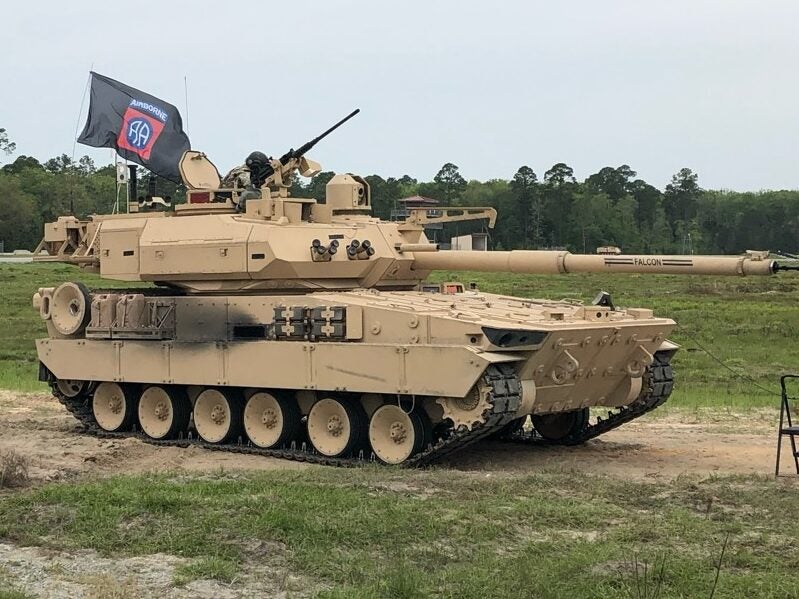
The US Department of Defense (DoD) has confirmed that General Dynamics Land Systems will deliver an initial 24 Mobile Protected Firepowers (MPF) in Q1 of 2024, part of a $1.14bn contract to supply 96 vehicles. The lightly-armoured land platform will fill a capability gap in infantry brigades for an airborne-capable tracked vehicle that can provide fire-on-the-move capability.
“The MPF programme initiated the Low-Rate Initial Production (LRIP) phase…in June 2022,” said US Army spokesperson Ellen Lovett, told Army Technology, adding that LRIP deliveries were expected to occur in the first quarter of the financial year 2024.
Integrated MPF and infantry deployment
After MPF crews have established logistics and strategic practices the platform will attach with US Army Infantry Brigade Combat Teams (IBCTs), where they will train together to establish a new battlefield role.
“The MPF is a new capability to the IBCTs. It provides IBCTs with mobile, protected direct fire capability to apply lethal and sustained long-range fires to armoured vehicles, hardened enemy fortifications and dismounted personnel,” said Lovett.
In a Life Cycle Environmental Assessment published by the US Army in August last year, the MPF project management team were explicit about the requirements for the vehicle, stating that “the MPF will be a highly mobile, multi-terrain, armoured tracked vehicle with direct-fire capabilities”.
“Two MPFs must be transportable in an operational, drive-on/drive-off configuration in a single C-17 aircraft and allow unrestricted highway, rail, and marine transport worldwide,” the LCEA report continued, highlighting the central requirement for mobility and airborne deployment. “Transport constraints limit the MPF’s physical dimensions and its weight to approximately 42 tons.”
A Congressional Research Service (CRS) report from 18 May 2022, was clear about the strategic niche the MPF is filling: ‘Currently the Army’s Infantry Brigade Combat Teams do not have a combat vehicle assigned that is capable of providing mobile, protected, direct, offensive fire capability.’
Tristan Sauer, land domain analyst at GlobalData, speaking in July of the last airborne-capable tracked vehicle the US Army maintained, said: “The capability gap left by the retirement of the M551 Sheridan light tank in 1996 has been a point of contention since the end of the First Gulf War.”
The Sheridan’s capabilities had been formidable, equipped with an autoloader that had been state-of-the-art when first delivered, but its technological shortfalls had been a liability for IBCTs and maintenance requirements hampered manoeuvrability.
In an Association of the US Army article published in 10 December 2021, Lt Col Ben Ferguson and Capt Lennard Salcedo point to potential criticism over how the MPF could still encumber the IBCTs mobility, with MPF maintenance and resupply adding to the list of tasks operational control units have to manage.
The authors noted that integration into an IBCT will provide “organic logistic support” for the platform, mitigating some of the drawbacks of alternative armoured assets with better communication and enhanced understanding of requirements. Managing the logistical footprint then becomes a planning factor for leadership rather than a limitation to operations.
Rapid production
By integrating existing mature technologies and components the development of the MPF has avoided challenges which would lengthen the program schedule, according to the CRS report.
The flexible middle-tier acquisition legislation granted by Congress in 2016 allowed for “accelerated prototype delivery”, said Doug Bush, the US Army’s acquisition executive. The middle-tier approach prioritises rapid development by exempting the programme from many existing DoD acquisition processes and policies.
A 2020 US Government Accountability Office (GAO) report into the Next Generation Combat Vehicle programme estimated for the MPF life-cycle cost was approximately $16bn for the complete programme, comprehensive of research and development, evaluation, procurement, operations and support, and disposal. The GAO was cautious about the rapid development process being implemented: “The Army’s plans for these tanks and other armoured vehicles prioritise rapid development. That can limit insight into potential risks.
“The Army took some steps to reduce the risks of cost overruns and programme delays,” continued the GAO. “The Army didn’t fully consider all potential cost uncertainties. It also delayed key engineering reviews for these efforts, increasing the risk of vehicle design problems.”
However, the middle-tier acquisition authorities enabled the US Army to quickly move prototypes into the crews’ hands for limited user testing and soldier vehicle assessment during mid-tier acquisition rapid prototyping phase, according Lovett, with soldier feedback provided to the original equipment manufacturers “in enough time for them to modify their vehicle designs and update their Low-Rate Initial Production proposals.”
The CRS report also expressed concern over the integration of the MPF into service given current recruiting challenges, as each MPF company requires 64 armour crewman and 24 maintenance soldiers to maintain the platforms systems.
Furthermore, the CRS acknowledged the challenges around the MPF’s central weapon. Instead of 120mm ammunition that is the standard across NATO partners, the MPF’s cannon uses 105mm ordnance that is uncommon enough for “industrial base-associate munition production challenges” to be a concern in the face of the current limited quantity of on-hand, serviceable 105mm ammunition.





